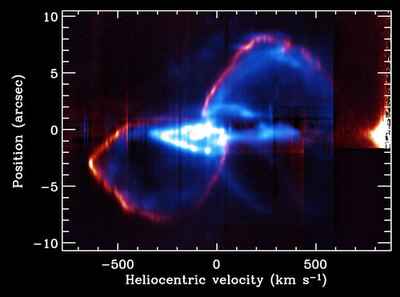The current structure of the nebula, reminiscent of a human fetus, was created by the expansion which is not uniform on all sides but mainly to two poles, while the material is surrounded by layers of gas and dust

Although the embryonic nebula orbiting the massive star Eta Carinae has been the subject of extensive research for many years, it has always refused to reveal its most hidden secrets. But an important chapter in the current evolution of this unique star was revealed when Nathan Smith of the University of Colorado used the Phoenix High-Resolution Infrared Spectrograph at the Gemini South Observatory to observe the bipolar nebula surrounding Ata Karina.
Multi-slit spectroscopy allowed Smith to reconstruct both the geometry and the velocity structure of the gas propagating in the nebula based on the behavior of the H2 hydrogen molecules at 2.1218 microns and the ionized iron atomic line at 1.6436.
The analysis of the spectrum as captured by the Phoenix systems shows a recognizable shell structure spreading at a speed of 500 kilometers per second, a thick layer of compressed dust crust that can be detected thanks to the emissions of the ionized iron on its surroundings, cooled by the outer layer characterized by strong hydrogen emissions. Although the outer hydrogen layer is much thinner and more uniform, its total mass is about 11 solar masses of gas and dust ejected over a period of less than five years. The spectrum of Gemini showed that the density in the outer layer may reach 107 particles per cmXNUMX.
The current structure of the nebula, reminiscent of a human fetus, was created by the expansion which is not uniform on all sides but mainly to two poles, while the material is surrounded by layers of gas and dust. According to Smith, these data indicate that most of the mass lost during the mid-19th century eruption was confined to the star's high latitudes, with almost all of the material from the 45th latitude to the poles erupting into space. The mass distribution in the nebula indicated that its shape is a direct result of an asymmetric explosion from the star itself, rather than being influenced by other stars in the area." Smith said.
